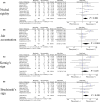Sensitivity and specificity of meningeal signs in patients with meningitis
- PMID: 31516806
- PMCID: PMC6732499
- DOI: 10.1002/jgf2.268
Sensitivity and specificity of meningeal signs in patients with meningitis
Abstract
Background: Several types of physical examinations are used in the diagnosis of meningitis, including nuchal rigidity, jolt accentuation, Kernig's sign, and Brudzinski's sign. Jolt accentuation was reported to have sensitivity of nearly 100% and to be highly efficient for excluding meningitis, but more recent studies showed that a number of patients with meningitis may present negative in this test.
Methods: We systematically reviewed studies on the above-mentioned physical examination tests and performed meta-analysis of their diagnostic characteristics to evaluate the clinical usefulness. Nine studies, comprising a total of 599 patients with pleocytosis in the cerebrospinal fluid (CSF) and 1216 patients without CSF pleocytosis, were enrolled in the analysis.
Results: Jolt accentuation showed a decent level of odds ratio (3.62; 99% confidence interval (CI): 1.13-11.60, P = 0.004) comparable to that in nuchal rigidity (2.52; 1.21-5.27, P = 0.001) for the correct prediction of CSF pleocytosis among subjects with suspected meningitis. The estimated sensitivity was relatively high (40%-60%) in nuchal rigidity or jolt accentuation tests. On the other hand, Kernig's and Brudzinski's signs exhibited relatively low sensitivity (20%-30%). The estimated specificity was higher in Kernig's and Brudzinski's signs (85%-95%) than in nuchal rigidity or jolt accentuation tests (65%-75%).
Conclusion: Approximately half of the patients with meningitis may not present typical meningeal signs upon physical examination. Combining several examinations for the detection of meningeal signs may decrease the risk of misdiagnosis.
Keywords: Kernig's sign; jolt accentuation; meningitis; meta‐analysis; nuchal rigidity.
Conflict of interest statement
The authors have stated explicitly that there are no conflicts of interest in connection with this article.
Figures


Similar articles
-
Diagnostic test accuracy of jolt accentuation for headache in acute meningitis in the emergency setting.Cochrane Database Syst Rev. 2020 Jun 11;6(6):CD012824. doi: 10.1002/14651858.CD012824.pub2. Cochrane Database Syst Rev. 2020. PMID: 32524581 Free PMC article.
-
The diagnostic accuracy of Kernig's sign, Brudzinski's sign, and nuchal rigidity in adults with suspected meningitis.Clin Infect Dis. 2002 Jul 1;35(1):46-52. doi: 10.1086/340979. Epub 2002 Jun 5. Clin Infect Dis. 2002. PMID: 12060874
-
Jolt accentuation of headache: can this maneuver rule out acute meningitis?BMC Res Notes. 2017 Oct 30;10(1):540. doi: 10.1186/s13104-017-2877-1. BMC Res Notes. 2017. PMID: 29084605 Free PMC article.
-
Jolt accentuation of headache and other clinical signs: poor predictors of meningitis in adults.Am J Emerg Med. 2014 Jan;32(1):24-8. doi: 10.1016/j.ajem.2013.09.012. Epub 2013 Oct 16. Am J Emerg Med. 2014. PMID: 24139448
-
How to use clinical signs of meningitis.Arch Dis Child Educ Pract Ed. 2020 Feb;105(1):46-49. doi: 10.1136/archdischild-2018-315428. Epub 2019 Jan 28. Arch Dis Child Educ Pract Ed. 2020. PMID: 30692129 Review.
Cited by
-
Bacterial meningitis or cobalamin deficiency: A diagnostic conundrum.J Family Med Prim Care. 2022 Jun;11(6):3318-3320. doi: 10.4103/jfmpc.jfmpc_1428_21. Epub 2022 Jun 30. J Family Med Prim Care. 2022. PMID: 36119292 Free PMC article.
-
Clinical and biochemical profile of scrub typhus patients at a tertiary care hospital in Northern India.J Family Med Prim Care. 2021 Mar;10(3):1459-1465. doi: 10.4103/jfmpc.jfmpc_1162_20. Epub 2021 Apr 8. J Family Med Prim Care. 2021. PMID: 34041194 Free PMC article.
-
Aseptic Meningitis With an Isolated Positive Ocular Globe Compression Sign Diagnosed by Repeat Lumbar Puncture.Cureus. 2022 Nov 30;14(11):e32036. doi: 10.7759/cureus.32036. eCollection 2022 Nov. Cureus. 2022. PMID: 36600832 Free PMC article.
-
The diagnostic value of the neurological examination in coma of unknown etiology.J Neurol. 2021 Oct;268(10):3826-3834. doi: 10.1007/s00415-021-10527-4. Epub 2021 Apr 1. J Neurol. 2021. PMID: 33796895 Free PMC article.
-
Author reply to "Caution about overdiagnosis of neck calcification".J Gen Fam Med. 2020 Nov 19;22(3):164-165. doi: 10.1002/jgf2.406. eCollection 2021 May. J Gen Fam Med. 2020. PMID: 33977019 Free PMC article. No abstract available.
References
-
- Bryan JP, de Silva HR, Tavares A, Rocha H, Scheld WM. Etiology and mortality of bacterial meningitis in northeastern Brazil. Rev Infect Dis. 1990;12:128–35. - PubMed
-
- van de Beek D, de Gans J, Tunkel AR, Wijdicks EF. Community‐acquired bacterial meningitis in adults. N Engl J Med. 2006;354:44–53. - PubMed
-
- Attia J, Hatala R, Cook DJ, Wong JG. The rational clinical examination. Does this adult patient have acute meningitis? JAMA. 1999;282:175–81. - PubMed
-
- Uchihara T, Tsukagoshi H. Jolt accentuation of headache: the most sensitive sign of CSF pleocytosis. Headache. 1991;31:167–71. - PubMed
LinkOut - more resources
Full Text Sources
